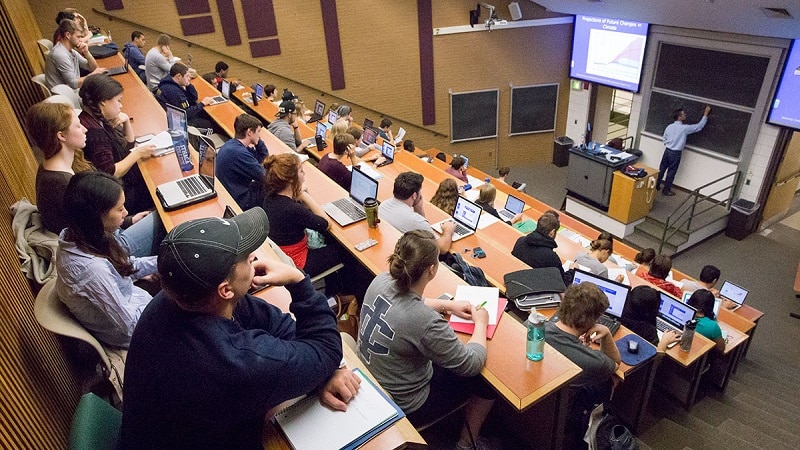
The process of education is pretty complex, and it’s vital to simplify it. Thus, learners will be able to get the maximum from it. Otherwise, they may not understand a lot of important things that help to become successful. Many people claim that technology is a perfect medium that simplifies the educational process and even encourages students to try harder.
Lauren Bradshaw, an experienced and skilled freelance essay writer from Custom Writings, has an interesting opinion about the use of technology in the classroom. “It’s not possible to define a perfect medium for education and even the best technological devices will have some drawbacks. Nevertheless, they can be used wisely to be close to perfection”.
Lauren means that technology isn’t perfect, but it has the potential to be almost perfect if it’s used reasonably. Our analytical article will shed light on the pros and cons of technology in the college classroom.
Pros

We’ll begin with the benefits provided by technology. There are several really vital pros. Make allowances for:
- Multiple Sources
One of the greatest advantages of using technology in the college classroom is access to all kinds of information. They can be easily and quickly accessed via the Internet. Students can find the necessary scientific evidence from:
- Scientific articles;
- Textbooks in digital formats;
- Educational events (forums, webinars, etc.);
- Online lessons and conferences;
- Learning courses and programs;
- Official websites of all colleges and universities;
- Non-commercial sites similar to Wikipedia;
- Governmental sites and other sources.
Students can download most articles for free. There are no fees charged for accessing educational, governmental, or non-commercial websites. It’s possible to participate in educational events without paying for them.
- Instant Access
As students use the Internet, they can find the necessary information straight away. It can be done thanks to the 4G technology, which enables almost instant access. Moreover, many colleges and universities already use 5G, which is much faster and more dependable. All that is left to do is to use a search key in your browser and click on the necessary link. The site will instantly open.
- Cost-Effective
Another great benefit is the cost. Technological devices have their price. Nonetheless, after it is paid students save up heaps of money. There is no more need for buying numerous textbooks, papers, pens, and similar stuff. Almost everything can be downloaded to a laptop for free. These are all kinds of apps, tools, and e-books.
- Greater Engagement
Thanks to technology, students get more enthusiastic in the learning process on average. They find it more inspiring and interesting because the standard writing, reading, and other tasks can be fulfilled with the help of smart learning apps, devices, and tools.
For example, students can generate relevant topics by using topic generators. They only should use 1-2 words and get the best variants in the chosen subject.
Another example is the use of grammar checkers. Youngsters may identify the mistakes they miss thanks to these smart tools. They scan texts and show mistakes with corrections and explanations.
- More Convenient
Technology promotes speed, productivity, and convenience. For example, you can write and save your academic notes by using a laptop. Everything is instantly saved on your device, and you can edit the file whenever you want.
It doesn’t require using new notebooks, pens, pencils, and similar stuff. Students can shape documents to their liking.
Cons

Technology may be harmful to learners as well. Certain facts explain why. Here are the main cons of using technology in the college classroom:
- Distraction
Using technology may drive away attention. One study, conducted by Arnold Glass is a professor in the School of Arts and Sciences at Rutgers University in New Brunswick, New Jersey, revealed that technology lowers student attention. It involved 118 students who were allowed to use any apps they wanted during a certain period of time.
Students passed everyday tests, as well as weekly and final tests. The results showed that they had poorly performed on questions related to material taught during final exams. The head of the research believes that many of them used their gadgets for tasks that had no relation to their studies.
- Mental Addiction
Many people get alarmed by the strong influence of technology on young minds. Children get addicted to it and it may lead to mental deviations. Among such is depression.
Thus, one research proved that regular use of technology may provoke a slight increase in anxiety, which can possibly lead to depression. As the research was limited, it cannot explain the reasons and associations with technology and depression in students. It should be studied more. However, a negative tendency is obvious. Therefore, students should not overuse technology.
- Physical Issues
Technology can negatively affect human physical health in a long run. As students spend tons of time in front of the screen, their sight gets weaker and it may even lead to eye degradation. Another possible issue is obesity. Children are drawn to their gadgets, don’t follow an active lifestyle, and eat junk food. It leads to excess weight and muscle weakness.
- Problems with Memory
Some scholars believe that active use of technology may cause problems with memory. Handwriting helps to improve cognitive functions, including memory and thinking. If children type on their laptops, they get deprived of this vital cognitive boost. It slows down cognitive development and students begin to fall behind the normal curriculum.
- Social Isolation
If a person is obsessed with technology, he/she may get engulfed by it and get socially isolated. He/she may perfectly chat online, but find it extremely difficult to interact with people in reality. Virtual communication is less social and many children suffer from it in time.
Using technology in the classroom has two sides. It has great benefits, as well as serious drawbacks. Therefore, college boards ought to implement it carefully and control the way students use technological devices to avoid potential complications.










